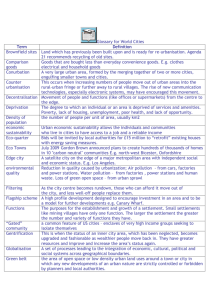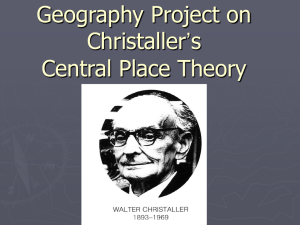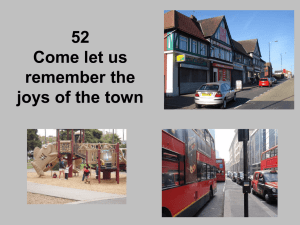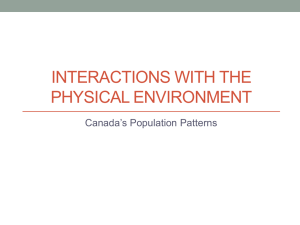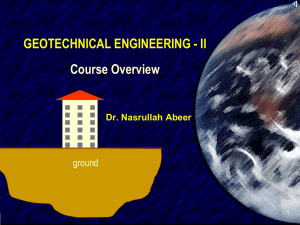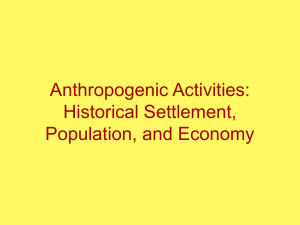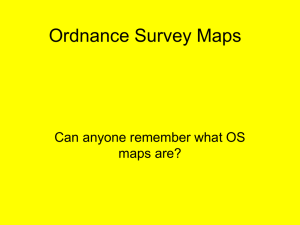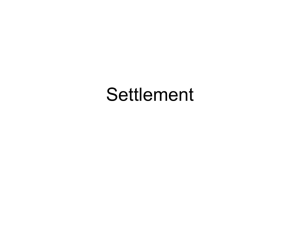Theme F – Settlement
advertisement
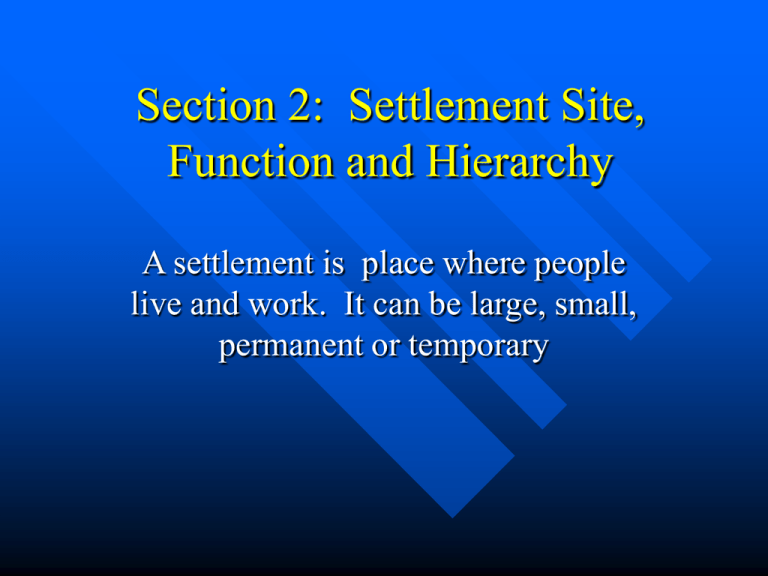
Section 2: Settlement Site, Function and Hierarchy A settlement is place where people live and work. It can be large, small, permanent or temporary Part 1: Distinguish between site and location of a settlement Settlements have developed over time Location and growth of settlements are related to physical and human factors The first consideration about any settlement is its location. Why is a settlement found in a particular place? What are the reasons why this SITE was chosen as opposed to another place? The Site of a settlement The site of a settlement is The point at which the town (or hamlet, village or city) is located. The town is located at this place (its ‘building site’) because they have one or more advantages. What are the main factors? The Situation of a settlement The situation of a settlement helps to describe where the settlement is located with reference to other features like other settlements, mountains, rivers and communications – it is situation that determines whether the place will continue to grow Location Advantages Wet point site Dry point site Building materials Defence Fuel Supply Food supplies Nodal points Bridging points Shelter and aspect Drinking water supply High ground to avoid flooding Wood and stone Views, rivers and slopes Heating and cooking Farming land – good soil Where 2 routes meet Ford – river crossing point South Facing slopes The thing to remember . . . . . . . Is that most cities, towns and villages grew up many years ago. As the places grew into villages and then onto towns and eventually into cities they changed and many forgot the actual ‘site’ reasons – in the 19th and 20th centuries many of the physical advantages were replaced by human factors Question – what factors are important for the development of settlements today? Location Advantages Wet point site Dry point site Building materials Defence Fuel Supply Food supplies Nodal points Bridging points Shelter and aspect Political factors Economic factors Water is piped – not important River banks are built up Cement shipped in Not important Fuel shipped in Food shipped in Possibly more important? Rivers crossed anywhere Not important Government policy/planning Are some parts rich/poor The Site of Belfast Belfast was a river crossing point (or ford). In fact it was almost an accident that Belfast grew at all as Carrickfergus was more important until the 18th Century when Belfast’s position (and function) allowed it to grow into the main industrialised city in Ireland So what about Ballymena then? What are the different reasons for the growth of Ballymena? What is a Settlement Function? The function of a settlement is the main activity that a settlement has. It relates to the main job that a place has - for example the main function of Belfast would be . . . What are the main functions? Market Towns Mining Towns Industrial Towns Ports Route Centres Service Centres Cultural/Religious centres Administrative Centres Residential Towns Tourist Resorts Can you think of an example for each of these in Northern Ireland Market Towns Mining Towns Industrial Towns Ports Route Centres Service Centres Culutral/Religious centres Administrative Centres Residential Towns Tourist Resorts Do Settlements have different Patterns? The notes from Page 20 and 21 are taken from ‘The wider world’ and they explain the relationship between the function and settlement patterns. Basically, settlements are shaped in different ways Threshold Population This is the number of people that are needed to make sure that there is enough demand for a particular service For example – 350 people are needed for a village shop 2,500 people are needed for a doctor 10,000 people are needed for a secondary school 50,000 people are needed for a Marks and Spencer 60,000 people are needed for a Sainsbury’s Range This is the maximum distance that people are prepared to travel in order to get or use a service. People are not prepared to travel far to a corner shop but will travel longer distances to shop in supermarket or a furniture store

